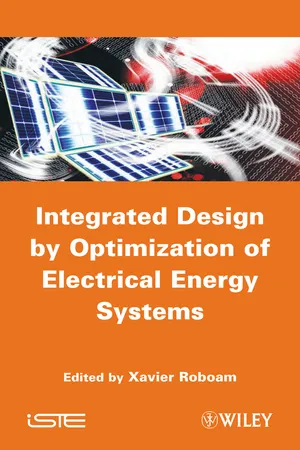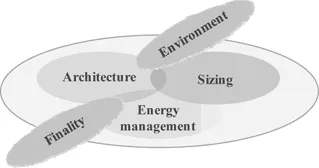![]()
Chapter 1
Mission and Environmental Data Processing1
1.1. Introduction
Energy systems design, particularly electrical, is nowadays increasingly influenced by social issues linked to energy economy policies and reducing the impact on the environment. To this end, numerous technical demands are added, such as volume and mass, lifetime, reliability (see Chapter 8, [ROB 12]), quality (susceptibility, harmonic pollution), stability (see Chapter 5 [ROB 12]), and recyclability. Being strongly linked to cost criteria, these demands require design to be tackled according to a “technicoeconomic” approach. Thus, the end of the 20th Century was marked by a notable evolution towards a more complete evaluation of costs over the whole of the lifecycle of the system (production, maintenance, and usage costs, even dismantling/recycling costs). Faced with these new considerations, designers are called upon to consider the environment in which their systems will evolve in more detail. Fundamentally, it is imperative to evolve toward a “systems design” approach from the outset; thus enabling an understanding of the coupling between system constituents and facilitation and the integration of the utility of the device and environmental variables.
This heterogeneous and complex set of requirements is pushing designers towards a “simultaneous design” approach, which truly integrates systems design, as indicated in this introductory chapter (see also Chapter 1 of [ROB 12]). Simultaneous design is an approach that considers the system as a whole, where the fundamental questions of system architecture, sizing and management are integrated (see Figure 1.2). As we will see in Chapter 3 of this book, simultaneous design can be handled using optimization techniques, which is where multiple levels of difficulty are jointly associated with the design problem.
The integration of the “mission” (or finality) and environmental variables into the design process is particularly difficult, as the mission profile duration, and environmental variables (such as temperature, wind, and sunshine) are generally longer than the dominant time constants of the system, leading to significant processing times (simulation, optimization), which limit research into optimum solutions. This difficulty becomes all the more critical from the moment the system under design needs to satisfy not only a unique profile (mission and/or environmental variable), but a family or class of profiles with occasionally different characteristics. Indeed, in a profile database, there is generally no single “dominant” profile with regards to the set of design criteria and constraints (indicators); frequently, only a single part of a profile is “relevant” with regards to a first indicator, whereas another profile part is particularly constraining with regards to a second indicator, etc. The selection of a representative “sizing” profile is not therefore straightforward and constitutes an essential stage; it is an “integral part” of the systems design process.
Therefore, this current chapter presents a methodological approach aimed at mission and, more generally, environmental variable (mission, storage, boundary conditions) “profile processing”. This approach constitutes the essential upstream phase of a systems design process. The first incontrovertible phase of the design process, the “classification” and “synthesis” of profiles relative to the environmental variables of the system, guarantees the quality of the device under design, and this is conditional on pertinent design criteria and constraints.
We place particular emphasis in this chapter on the contribution of our approach in the context of design by optimization, dealt with in Chapter 3, which, as it requires a large number of iterations (design solution evaluation), forces the use of “compact profiles” at a data level (such as time, frequency and statistical).
In this chapter, we provide a brief overview of how the mission and environmental variables are taken into account in the design process. We highlight the basic concepts of our new approach to processing these variables. We describe two applications, which will serve to illustrate our proposal; these examples concern the processing of railway missions for the design of a hybrid locomotive and the processing of wind energy resources. For each example, we formulate the set of pertinent indicators with regards to design criteria and constraints. These two deliberately very distinct examples enable the generic nature of the proposed methodological approach to be illustrated. Then, we discuss the classification of missions and environmental variables according to the design indicators, and describe the representative reduced duration mission synthesis process for which the characterization indicators correspond to the real data reference characteristics. Finally, we apply this approach to the “simultaneous design” by optimization of an economic hybrid locomotive in terms of energy and environmental respect.
1.2. Considerations of the mission and environmental variables
In this section, we propose innovations regarding integration and consideration of missions and environmental variables in systems design, particularly in electrical engineering and, more generally, for multiphysical energy devices.
1.2.1. Mission representation through a nominal operating point
The design of certain artifacts, such as electric motors, is often tackled by considering sizing at a nominal operating point [MES 98]. This point is easily identifiable for industrial applications, where the charge is considered to be constant and where the “traction” speed is set. This relatively simple approach is immediately challenged for electrical traction applications under variable conditions, where the operating points follow torque-speed trajectories. In principle, it is not easy to reduce the unit from a trajectory to a single nominal operating point, nor is it very pertinent. For the nominal sizing point, a possible simplification consists of considering a point relative to the maximum torque and speed of the trajectories, i.e. a point that energetically controls the trajectory points. This approach enables a response to the problem of energetic sizing, but mostly results in an undersizing of the system relative to the total requirement. In addition, the energy efficiency of the system is optimized in an operating zone close to the nominal point, which does not necessarily correspond to points of the highest occurrence points. It is therefore possible, within a second approach, to consider as a sizing point some particular operating points (such as the point of highest occurrence), but this solution may conversely result in “oversizing”, which does not enable the whole of the trajectory to be satisfied. Finally, the recent experience of the LAPLACE/GENESYS research group [DEA 12] has shown that certain points that were not energetically relevant could turn out to be critical, with regards to certain design criteria or constraints; one example is the case of normative quality constraints of wave forms at the input of an actuation system, which are violated during low speed, yet “power hungry” operation.
1.2.2. Extraction of a “sizing” temporal chronogram
Here, this type of approach is illustrated using the design of an electrical aeronautical emergency network as an example [LAN 06]. This involved the sizing of a basic hybrid emergency network for a ram air turbine (RAT) acting as a source of energy, ensuring a power level close to the average power associated with a storage element acting as a power source in order to feed the fluctuating part of the mission. In th...

